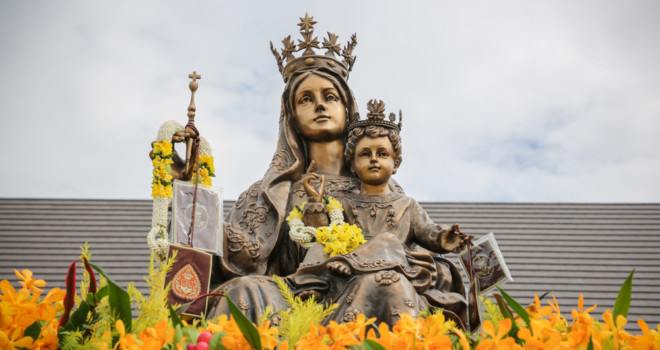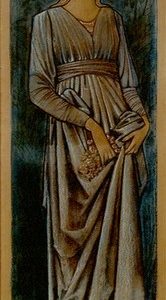My mother is no longer in contact with me, and even prior to that, she was emotionally abusive for years. For years, I have found myself “motherless” — rejected by my own mother, who is not capable of healthy relationship or love.
Because of this, is has always been hard for me to think of
the Blessed Mother as my mother. For me, “mother” does not necessarily
equal unconditional love.
A Child’s View of Mary
My children, being parented by a mother who has chosen to
break the cycle of abuse, do not have the same problem. My middle daughter is
absolutely obsessed with Mary. She is practically a Mary evangelist. (For a
brief period of time, our toddler referred to the Eucharist and images of Jesus
as “Mar-ee!” because she didn’t know how to say Jesus, but her big sister had
taught her how to say Mary.) The other day, I took my children to adoration
at our parish. Before we had walked to church, we had picked a few flowers, and
my little Mary fan clung to hers. When she asked what she should do with it, I
suggested putting it on the little side altar devoted to Mary (which she
thought was an excellent idea).
Later, I went back to adoration to pray alone. I was praying
about my childhood, and was thinking about my mother. Then, I glanced at the
Mary altar and saw a little, slightly wilted tiger lily. It was the flower from
my daughter.
For my daughter, “mother” is synonymous with “unconditional
love.” For her, it is easy to understand and believe that Mary loves her.
Mary’s motherly love (and all healthy, motherly love) isn’t contingent on
anything we do or don’t do. It isn’t contingent on our perfection. It is constant,
no matter how we may fall short.
Mary in Our Lives
As I knelt in adoration that night, I was reminded that
Mary’s love for me had been constant. In fact, her prayers undoubtedly
played a large role in my own healing and ability to break free from the abuse
of my childhood. She has loved me for my
entire life.
Even without as dramatic a reason as mine, many people
experience “motherlessness” in their own lives. Sometimes, it is something as
simple as wanting a mother who you are separated from geographically. Others
may have experienced the death of their mother, or may have been separated from
their mother at birth or during childhood. Mary wants to be that mother, the
mother to those who are currently without one. She wants to be a mother to
those who have a mother in their lives, too.
The Scapular and Marian Sacramentals
Catholics are notorious for their sacramentals, and many of
these point to Mary, and serve as a reminder of her intercession for us. The
Miraculous Medal, the rosary, and even statues of Mary serve as beautiful
reminders of her unconditional love.
But of special note is the brown scapular. Given to St.
Simon Stock by Mary, the scapular worn by the Carmelites is a particular
reminder of Mary’s love and protection.
If you have been enrolled in the brown scapular (which can
be done for you by any priest, typically on a Marian feastday) then you are
familiar with this simple little sacramental. It consists of two small squares or
rectangles, backed with wool felt (like a real Carmelite’s scapular), joined by
two ribbons or strings. One square usually has an image of Our Lady of Mount
Carmel (as she appeared to St. Simon Stock) and the other has her promise to
him, that anyone who dies wearing the scapular will not die and go to hell.
If that sounds like superstition, then it might be helpful
to consider this promise in light of Mary’s maternity. How can a couple of felt
squares save you from hell? They can’t – but entrusting yourself to your
heavenly mother can help you on your journey to heaven. There is a reason why
Jesus gave us Mary as our mother, when he was dying on the cross. He knew that
we all need a mother. He knew that, just as infants sleep more
peacefully when they are nestled on their mother’s chest, listening to her heartbeat,
we would be able to better walk through this valley of tears in the arms of our
mother. And what does our heavenly mother’s heart say? “Jesus. Jesus. Jesus.” You
can’t help but draw nearer to him, when you allow Mary to mother you.
So, what about the scapular? To wear a scapular is to be
held, constantly, by Mary. To wear a scapular is to experience being nestled
beside her heart as it beats, “Jesus. Jesus. Jesus.”
This is a comfort to all of us. And that is what the
scapular is meant to be – an experience of being mothered by the mother who comforted the tiny baby in Bethlehem, two thousand
years ago.












